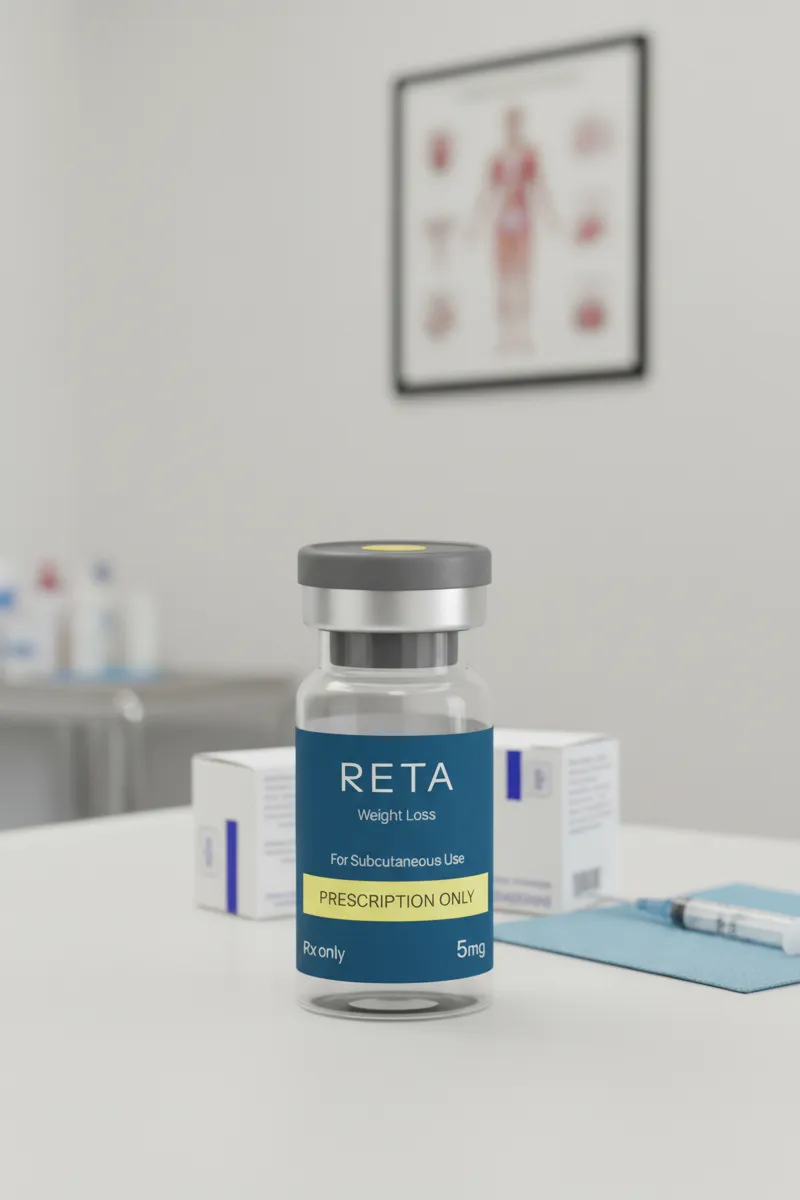Everything We Know About Retatrutide So Far (2025 Clinical Updates)
Retatrutide could be the next big step in weight-loss medicine. Learn what 2025 studies reveal about its results, safety, and how it compares to Ozempic, Wegovy and Zepbound.

Introduction
Weight-loss medicine has evolved faster in the past five years than in the previous five decades. Drugs like Semaglutide and Tirzepatide have already changed how doctors approach obesity – but Eli Lilly’s investigational therapy Retatrutide might push those limits even further.
If early data hold up, Retatrutide could deliver an average 24% body-weight reduction in less than a year – numbers previously seen only after bariatric surgery.
So, what exactly is Retatrutide, how does it work, and how does it stack up against the current heavyweights in this space? Let’s dig into what 2025 clinical data tell us.
What Is Retatrutide and How Does It Work?
Retatrutide (LY-3437943) is a triple hormone receptor agonist developed by Eli Lilly. Unlike existing GLP-1 drugs that target a single hormone pathway, Retatrutide activates three:
- GLP-1 (Glucagon-Like Peptide-1) – regulates appetite and slows digestion.
- GIP (Glucose-Dependent Insulinotropic Polypeptide) – supports insulin release and metabolic efficiency.
- Glucagon receptor – helps burn fat by promoting energy expenditure.
In simpler terms, Retatrutide aims to suppress appetite, improve insulin function, and boost metabolism – a “triple-threat” mechanism that may explain its strong weight-loss results.
The drug is still in Phase 3 trials as of late 2025, but early data have drawn serious attention from the medical community and investors alike.
As Dr. Ania Jastreboff of Yale School of Medicine, lead investigator of the landmark 2023 NEJM study, explained:
“The magnitude of weight loss with Retatrutide is something we’ve never seen before in obesity pharmacotherapy.”
Clinical Results: What the Studies Show
Phase 2 Results (NEJM, 2023)
The pivotal Phase 2 trial published in The New England Journal of Medicine followed 338 adults with obesity (without diabetes) for 48 weeks. Participants received weekly injections of Retatrutide or placebo.
Average weight loss after 48 weeks:
- 1 mg – 8.7%
- 4 mg – 17.1%
- 8 mg – 22.8%
- 12 mg – 24.2%
- Placebo – 2.1%
At the top dose (12 mg), participants lost nearly a quarter of their body weight – an average of about 58 pounds (26 kg). For context, that’s roughly equivalent to outcomes seen after sleeve-gastrectomy surgery.
In addition to weight loss, researchers observed improvements in:
- Blood pressure
- Cholesterol levels
- Insulin sensitivity
- Liver fat reduction (a promising sign for MASLD/NASH patients)
Source: Jastreboff AM et al., NEJM 2023; 389(17): 1628–1639.
Phase 3 Trials (Ongoing in 2025)
As of 2025, Eli Lilly is running several Phase 3 programs:
- TRIUMPH-1 (NCT06859268) – weight management in non-diabetic adults
- TRIUMPH-2 – comparison with Tirzepatide in obesity
- TRIUMPH-3 – long-term maintenance and rebound tracking
Preliminary updates indicate that weight loss trends remain consistent with Phase 2 – with sustained reductions and acceptable tolerability. Final results are expected in 2026.
Dosing and Administration
Retatrutide is administered once weekly by subcutaneous injection, much like Semaglutide (Wegovy) or Tirzepatide (Zepbound).
In trials, doses were gradually escalated to limit side effects. The highest studied dose, 12 mg per week, produced the greatest weight reduction.
If approved, experts expect Lilly to recommend stepwise dose escalation (for example, 2 mg → 4 mg → 8 mg → 12 mg) over several weeks, to improve tolerability and reduce gastrointestinal discomfort.
Side Effects and Safety
Like other GLP-1-based therapies, the most common side effects are gastrointestinal.
Reported adverse events include:
- Nausea (around 30–40% of patients)
- Diarrhea or constipation
- Vomiting (typically during dose titration)
- Mild increase in heart rate (around 3–5 bpm)
Most side effects are mild or moderate and tend to lessen as the body adapts. So far, there have been no major safety concerns such as severe pancreatitis or thyroid cell abnormalities.
Eli Lilly has confirmed that its Phase 3 studies will include dedicated cardiometabolic safety endpoints to assess long-term effects.
How Does Retatrutide Compare to Semaglutide (Ozempic) and Tirzepatide (Zepbound)?
To understand Retatrutide’s potential, it helps to compare it with the current market leaders in GLP-1-based therapy:
Semaglutide (Ozempic, Wegovy):
- Mechanism: GLP-1 agonist
- Average weight loss: ~15%
- Duration: 68 weeks
- Proven standard
Tirzepatide (Zepbound)
- Mechanism: GLP-1 + GIP dual agonist
- Average weight loss: ~20–21%
- Duration: 72 weeks
- Superior to Semaglutide in SURMOUNT-1 trial
Retatrutide (RETA)
- Mechanism: GLP-1 + GIP + Glucagon triple agonist
- Average weight loss: ~24%
- Duration: 48 weeks
- Status: Investigational (Phase 3)
In short, Retatrutide extends the mechanism of Zepbound by adding glucagon activation – encouraging the body to burn energy rather than merely suppressing appetite.
Whether this triple mechanism can maintain safety and comfort long-term is the question 2026 studies aim to answer.
Why Retatrutide Matters
If Retatrutide delivers on its promise, it could mark the start of a new era in metabolic medicine – one where pharmacological weight loss matches surgical results with fewer risks.
Beyond appearance or body weight, this could have far-reaching public health impacts:
- Lower rates of type 2 diabetes
- Reduced cardiovascular disease
- Reversal of fatty liver disease
- Improved mobility and quality of life
While questions around cost, coverage, and long-term weight stability remain, Retatrutide’s data suggest a turning point in obesity care – a future where medication can achieve results once possible only through surgery.
Conclusion
By now, most people have heard of Ozempic, Wegovy, and Zepbound, but Retatrutide may soon join, or even surpass, that list. With promising clinical results and a unique triple-agonist approach, it stands out as one of the most powerful next-generation therapies in development.
Still, caution is warranted. Long-term safety, accessibility, and real-world adherence will determine whether Retatrutide becomes a lasting breakthrough or simply a major stepping stone in obesity care.
As Dr. Karen Miller, an endocrinologist at Brigham and Women’s Hospital, noted:
“We’re entering an era where obesity can finally be managed as a metabolic disease, not a personal failure.”
References and Medical Sources
Medical Disclaimer: This article is based on peer-reviewed clinical research and is intended for educational purposes only. It does not constitute medical advice.
- Jastreboff AM, Kaplan LM, Frías JP, et al. Triple-Hormone-Receptor Agonist Retatrutide for Obesity — A Phase 2 Trial. New England Journal of Medicine. 2023;389(17):1628-1639. https://www.nejm.org/doi/full/10.1056/NEJMoa2301972
- Rosenstock J, Frias J, Jastreboff AM, et al. Retatrutide, a GIP, GLP-1 and glucagon receptor agonist, for people with type 2 diabetes: a randomised, double-blind, placebo and active-controlled, parallel-group, phase 2 trial conducted in the USA. The Lancet. 2023;402(10401):529-544. https://pubmed.ncbi.nlm.nih.gov/37478931/
- Eli Lilly and Company. A Study of Retatrutide (LY3437943) in Participants With Obesity or Overweight (TRIUMPH-1). ClinicalTrials.gov Identifier: NCT05882045. https://clinicaltrials.gov/study/NCT05882045
- Wilding JPH, Batterham RL, Calanna S, et al. Once-Weekly Semaglutide in Adults with Overweight or Obesity. New England Journal of Medicine. 2021;384(11):989-1002. https://www.nejm.org/doi/full/10.1056/NEJMoa2032183
- Jastreboff AM, Aronne LJ, Ahmad NN, et al. Tirzepatide Once Weekly for the Treatment of Obesity (SURMOUNT-1). New England Journal of Medicine. 2022;387(3):205-216. https://www.nejm.org/doi/full/10.1056/NEJMoa2206038
- American Diabetes Association. Obesity and Weight Management for the Prevention and Treatment of Type 2 Diabetes: Standards of Care in Diabetes—2024. Diabetes Care. 2024;47(Supplement_1):S145-S157. https://diabetesjournals.org/care/article/47/Supplement_1/S145/153942/
- Samms RJ, Christe ME, Collins KA, et al. GIPR agonism mediates weight-independent insulin sensitization by tirzepatide in obese mice. Journal of Clinical Investigation. 2021;131(12):e146353. https://www.jci.org/articles/view/146353
- Heerspink HJL, Sattar N, Pavo I, et al. Effects of tirzepatide versus insulin glargine on kidney outcomes in type 2 diabetes in the SURPASS-4 trial: post-hoc analysis of an open-label, randomised, phase 3 trial. The Lancet Diabetes & Endocrinology. 2022;10(11):774-785. https://pubmed.ncbi.nlm.nih.gov/36184070/
- Müller TD, Finan B, Bloom SR, et al. Glucagon-like peptide 1 (GLP-1). Molecular Metabolism. 2019;30:72-130. https://www.ncbi.nlm.nih.gov/pmc/articles/PMC6812410/
Frequently Asked Questions
Ozempic and Wegovy activate only the GLP-1 receptor. Retatrutide also targets GIP and glucagon receptors, combining appetite suppression with higher metabolic output.
In clinical studies, participants lost up to 24% of their body weight after 48 weeks on the highest dose – roughly 50–60 pounds for an average adult.
Not yet. As of late 2025, Retatrutide remains in Phase 3 clinical trials. FDA submission is expected after final results in 2026.
If Phase 3 results confirm its safety and efficacy, experts expect FDA submission and potential approval in 2026, followed by market availability soon after.
Related Topics
Evidence-based articles to support your journey toward sustainable health.
Register your interest in Retatrutide
Retatrutide is currently not available, but once it is approved, you’ll be the first to get notified. Sign up now and stay informed.
Simple one-time sign-up
Early access to availability updates
Exclusive status among the first users
Advantage over non-registered users
%201.webp)
.svg)



